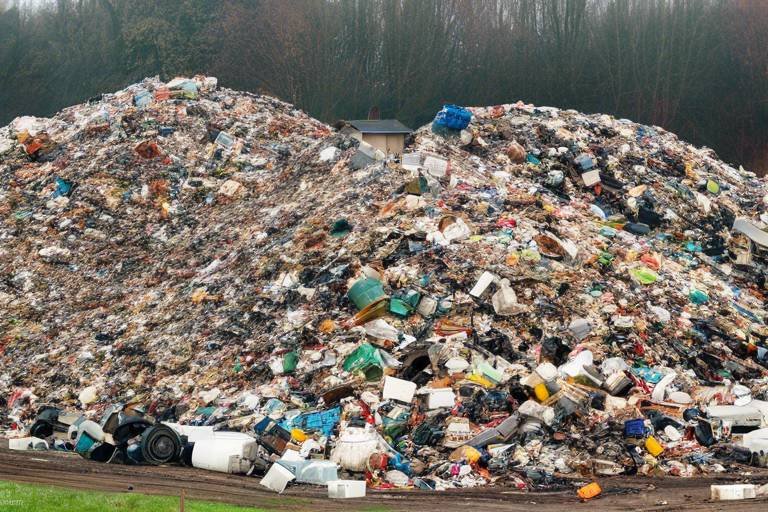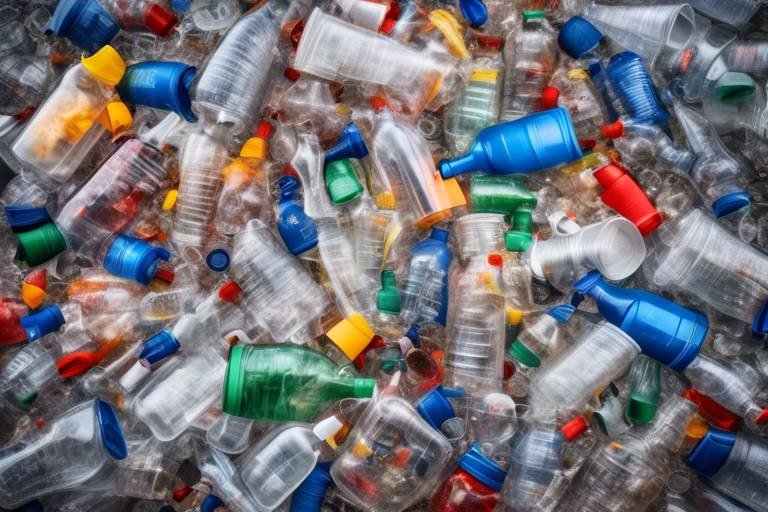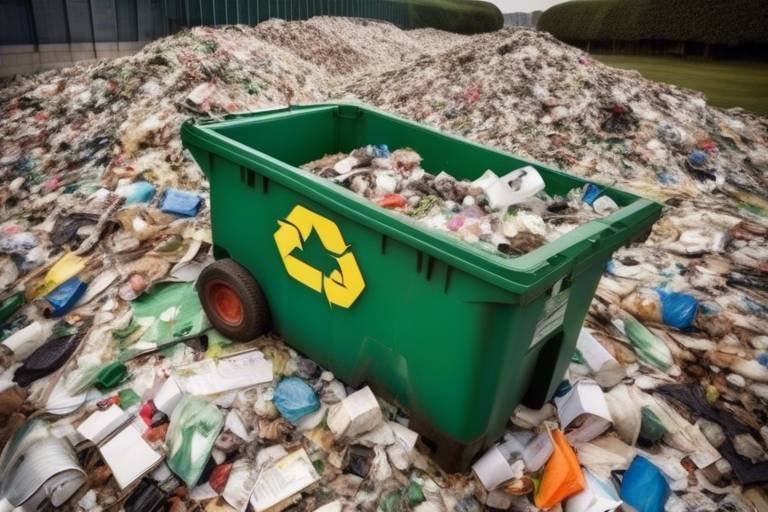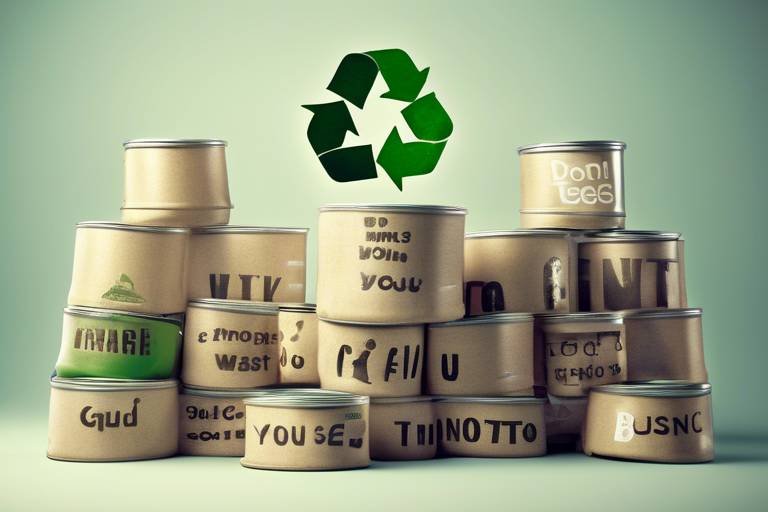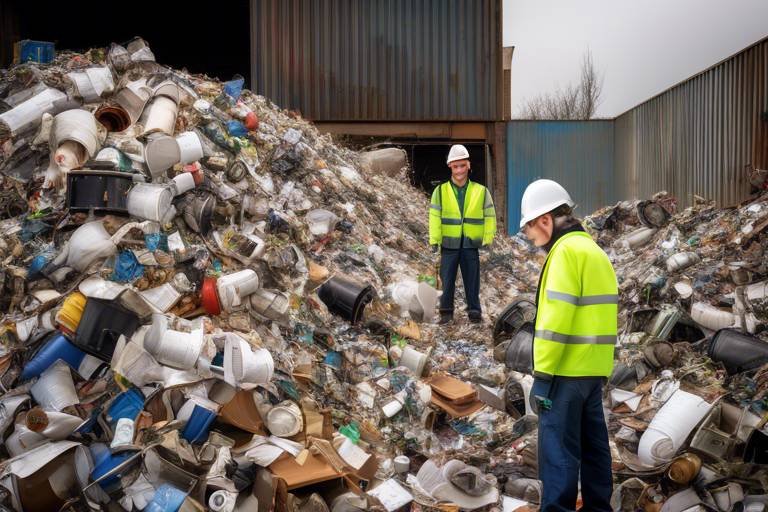Learning to Differentiate Between Biodegradable and Non-Biodegradable Waste
In today's world, where environmental awareness is at an all-time high, understanding the differences between biodegradable and non-biodegradable waste is more crucial than ever. With landfills overflowing and pollution levels rising, knowing how to manage waste effectively can make a significant difference in our planet's health. But what does it really mean when we say something is biodegradable? And why should we care about non-biodegradable waste? This article delves deep into these questions, shedding light on the critical distinctions between these two types of waste, their environmental impacts, and the importance of adopting sustainable waste management practices.
Biodegradable waste is composed of organic materials that can decompose naturally through the action of microorganisms. Think of it as nature's way of recycling! When biodegradable materials break down, they return nutrients to the soil, enriching it and promoting healthy ecosystems. This process is not just beneficial; it's essential for maintaining the balance in our environment. Common examples of biodegradable waste include food scraps, yard waste, and paper products. These materials, when managed properly, can significantly reduce the burden on landfills and contribute to sustainable waste management practices.
On the flip side, we have non-biodegradable waste, which consists of materials that do not decompose easily. This type of waste can linger in the environment for hundreds, if not thousands, of years. Think of plastics, metals, and glass—these materials are incredibly durable, but their longevity comes at a cost. Non-biodegradable waste poses serious environmental challenges, from pollution to habitat destruction. As we continue to produce and consume at alarming rates, the consequences of ignoring this type of waste become increasingly dire.
When we talk about biodegradable waste, we're referring to a variety of organic materials that can break down naturally. Here are some common types:
- Food Waste: This includes leftovers, fruit peels, and vegetable scraps. Food waste is a significant contributor to landfills, where it decomposes anaerobically, producing methane—a potent greenhouse gas.
- Yard Waste: Leaves, grass clippings, and branches fall into this category. Yard waste can be composted, returning vital nutrients to the soil and helping to create a healthier environment.
- Paper Products: Items like newspapers, cardboard, and paper towels are also biodegradable. When recycled, they can be transformed into new products, reducing the need for raw materials.
Food waste is a major component of biodegradable materials, and its impact on landfills is staggering. When food waste decomposes in a landfill, it produces methane gas, which is significantly more harmful than carbon dioxide in terms of its greenhouse effect. Composting is an effective solution to mitigate this issue. By composting food scraps, we not only reduce landfill waste but also create nutrient-rich soil that can be used in gardens and landscaping, promoting a sustainable cycle of growth.
Yard waste, which includes leaves, branches, and grass clippings, is another significant aspect of biodegradable waste. Instead of tossing this material in the trash, homeowners can compost it or use it for mulch. This practice not only reduces the amount of waste sent to landfills but also enhances soil health, encourages biodiversity, and supports a thriving ecosystem. Imagine your yard as a mini-ecosystem, where every piece of organic matter plays a role in nurturing the environment!
Non-biodegradable waste includes materials that resist decomposition, leading to long-lasting environmental issues. Here are some prevalent types:
- Plastics: From bags to bottles, plastic waste is everywhere. It can take hundreds of years to decompose, posing significant threats to wildlife and ecosystems.
- Metals: Items like aluminum cans and tin cans can last indefinitely in landfills, contributing to soil and water pollution.
- Glass: Although glass can be recycled, when discarded improperly, it can remain in the environment for thousands of years.
Understanding the environmental impact of both biodegradable and non-biodegradable waste is crucial for fostering a sustainable future. Improper waste disposal leads to pollution, habitat destruction, and resource depletion. For instance, when non-biodegradable waste enters our oceans, it not only harms marine life but also disrupts entire ecosystems. The ripple effects of such pollution can be felt across the food chain, affecting everything from tiny plankton to large marine mammals.
Non-biodegradable waste significantly contributes to various forms of pollution, particularly plastic pollution. When plastics break down, they fragment into microplastics, which can be ingested by marine organisms, causing harm to wildlife and ultimately entering our food supply. The sheer volume of plastic waste generated globally is staggering, and unless we take action, the consequences will be dire for both the environment and human health.
Effective management of biodegradable waste can lead to numerous environmental benefits. Composting not only reduces landfill usage but also enriches the soil, promoting healthier plant growth. Additionally, by diverting biodegradable materials from landfills, we can significantly reduce greenhouse gas emissions. The advantages of managing biodegradable waste extend beyond just environmental benefits; they also foster community engagement and awareness about sustainability practices.
Q: What is the main difference between biodegradable and non-biodegradable waste?
A: The primary difference lies in their decomposition. Biodegradable waste decomposes naturally, while non-biodegradable waste does not break down easily and can persist in the environment for a long time.
Q: How can I manage biodegradable waste at home?
A: You can manage biodegradable waste by composting food scraps and yard waste, using biodegradable bags for trash, and recycling paper products.
Q: What are the environmental impacts of non-biodegradable waste?
A: Non-biodegradable waste contributes to pollution, harms wildlife, and leads to habitat destruction. It can also release harmful chemicals into the soil and water systems.
Q: Why is composting important?
A: Composting reduces landfill waste, enriches soil, and supports a sustainable cycle of growth, ultimately benefiting the environment and reducing greenhouse gas emissions.

Understanding Biodegradable Waste
Biodegradable waste is a term that refers to organic materials capable of breaking down naturally through the action of microorganisms, such as bacteria and fungi. This type of waste is a crucial component of our ecosystem, as it can return essential nutrients back to the soil, promoting healthy plant growth and sustaining life. Imagine a world where every piece of waste we generate could be transformed back into the earth, nourishing our environment instead of harming it. That’s the beauty of biodegradable waste!
So, what exactly qualifies as biodegradable? Generally, materials that are derived from living organisms fall into this category. This includes a wide array of items, such as:
- Food scraps: Leftovers from meals, fruit peels, and vegetable trimmings.
- Paper products: Newspapers, cardboard, and paper towels.
- Yard waste: Grass clippings, leaves, and branches.
These materials undergo a natural decomposition process, which can be accelerated through composting. Composting is like giving these organic materials a second life, allowing them to break down in a controlled environment where they can transform into nutrient-rich compost. This compost can then be used to enrich soil in gardens and farms, promoting sustainable agriculture and reducing the need for chemical fertilizers.
One of the most significant benefits of managing biodegradable waste effectively is its potential to reduce the volume of waste sent to landfills. When biodegradable materials decompose in landfills, they often produce methane, a potent greenhouse gas that contributes to climate change. By composting these materials instead, we not only reduce methane emissions but also create a valuable resource for our gardens and landscapes.
In summary, understanding biodegradable waste is vital for anyone interested in environmental sustainability. By recognizing what constitutes biodegradable materials and how they can be effectively managed, we can all contribute to a healthier planet. Remember, every small action counts! Whether it’s composting your kitchen scraps or recycling your paper, you’re playing a part in nurturing our environment.

Understanding Non-Biodegradable Waste
When we think about waste, it's easy to overlook the **impact** that non-biodegradable materials have on our planet. Non-biodegradable waste refers to items that do not break down naturally in the environment. These materials can linger for hundreds, if not thousands, of years, leading to a host of environmental challenges. Imagine a plastic bottle tossed aside, remaining intact long after we are gone. This stark reality highlights the importance of understanding what non-biodegradable waste is and why it matters.
Non-biodegradable waste is primarily made up of synthetic materials that resist decomposition. Common examples include plastics, metals, and glass. These materials are often convenient for consumers but come with a heavy environmental price tag. For instance, plastics are everywhere—from packaging to household items—and while they serve a purpose, their **persistence** in the environment is alarming. A plastic bag can take up to 1,000 years to decompose, during which time it can break down into microplastics, contaminating our soil and waterways.
Moreover, non-biodegradable waste poses significant challenges for waste management systems. Landfills are filled to capacity with these materials, leading to pollution and habitat destruction. As waste decomposes, it can release harmful chemicals into the soil and groundwater, further complicating the issue. The lifespan of non-biodegradable waste is a ticking time bomb, and without effective management strategies, we risk overwhelming our planet's ecosystems.
To illustrate the types of non-biodegradable waste, consider the following table:
| Type of Non-Biodegradable Waste | Examples | Environmental Impact |
|---|---|---|
| Plastics | Bottles, bags, containers | Pollution, wildlife hazards |
| Metals | Cans, aluminum foil | Soil contamination, resource depletion |
| Glass | Bottles, jars | Landfill overflow, potential hazards |
Each of these materials contributes to the growing problem of waste accumulation. The challenge lies not just in their disposal, but also in our consumption habits. As consumers, we play a crucial role in this cycle. By choosing sustainable alternatives and reducing our reliance on non-biodegradable items, we can help alleviate the pressure on our environment.
In conclusion, understanding non-biodegradable waste is essential for anyone who cares about the future of our planet. Recognizing the types of materials that fall into this category and their potential impacts can empower us to make informed decisions. After all, every small action counts in the grand scheme of environmental conservation.
- What is non-biodegradable waste? Non-biodegradable waste consists of materials that do not decompose naturally, such as plastics, metals, and glass.
- Why is non-biodegradable waste a problem? It contributes to pollution, habitat destruction, and resource depletion, posing significant challenges for waste management.
- How can we reduce non-biodegradable waste? By opting for sustainable alternatives, recycling, and reducing our consumption of single-use plastics.

Common Types of Biodegradable Waste
When we think about biodegradable waste, we're diving into a world of organic materials that are nature's very own recycling champions. These materials, which can break down naturally over time, play a vital role in our ecosystem. They not only reduce the amount of waste we send to landfills but also enrich the soil, promoting a healthier environment. So, what exactly falls under this umbrella? Let’s explore some common types of biodegradable waste that we encounter in our daily lives.
First up is food waste. This is perhaps the most significant contributor to biodegradable materials. Think about it: every time you peel an apple, toss out leftover spaghetti, or discard that wilted salad, you're generating food waste. Unfortunately, when food waste ends up in landfills, it doesn’t decompose in the way we’d hope. Instead, it can produce harmful methane gas—a potent greenhouse gas that contributes to climate change. However, when we choose to compost our food scraps, we can turn this waste into a valuable resource. Composting not only diverts food waste from landfills but also creates nutrient-rich soil that can be used in gardens and landscaping, closing the loop in a beautiful way.
Next, we have yard waste, which includes everything from fallen leaves to grass clippings and branches. During autumn, when the leaves change color and begin to fall, many of us find ourselves raking up piles of leaves. Instead of bagging them up and sending them off to the landfill, consider composting or mulching them. Yard waste can decompose naturally and return nutrients to the soil, promoting a thriving garden ecosystem. Plus, it’s an excellent way to reduce the amount of waste we produce while enhancing the beauty of our outdoor spaces.
Other examples of biodegradable waste include paper products, such as newspapers, cardboard, and paper towels. These items are made from organic materials and can break down relatively easily. However, it’s essential to ensure that the paper products are free from excessive inks or coatings, which can hinder the decomposition process. Recycling paper is another fantastic option, as it helps reduce deforestation and conserves natural resources.
In summary, biodegradable waste is not just a category of waste; it’s an opportunity for us to rethink how we manage our resources. By composting food scraps, recycling paper, and properly handling yard waste, we can significantly reduce our environmental footprint. The next time you’re about to throw something away, pause for a moment and ask yourself: “Can this be composted or recycled?” This simple question can lead to powerful changes in our waste management practices.

Food Waste
Food waste is an enormous issue that often gets overlooked in discussions about environmental sustainability. It's not just about what ends up in the trash; it's about the entire lifecycle of food, from production to consumption. When we think about food waste, we often picture uneaten leftovers or expired groceries, but the reality is far broader. In fact, according to the Food and Agriculture Organization (FAO), approximately one-third of all food produced globally is wasted. That’s a staggering statistic! Imagine the resources that go into producing that food—water, land, labor, and energy—all of which contribute to our ecological footprint.
When food waste ends up in landfills, it decomposes anaerobically, producing methane, a greenhouse gas that is significantly more potent than carbon dioxide. This process not only contributes to climate change but also wastes the nutrients that could have been returned to the soil through composting. Instead of allowing this valuable organic matter to rot away, we can embrace composting as a viable solution. Composting not only reduces the volume of waste sent to landfills but also enriches the soil, promoting healthier plants and reducing the need for chemical fertilizers.
Here are some common types of food waste that can be composted:
- Fruit and vegetable scraps
- Eggshells
- Coffee grounds and filters
- Grains and bread
- Leftover meals
By composting these materials, we can close the loop in our food system. Instead of viewing food waste as a problem, we can see it as an opportunity to create a sustainable cycle. Not only does composting help reduce landfill waste, but it also contributes to a healthier ecosystem by returning nutrients to the earth. It’s like giving back to Mother Nature what we borrowed! So, the next time you find yourself tossing out food scraps, consider the benefits of composting and how it can positively impact our environment.
In summary, tackling food waste is not just an individual effort; it's a collective responsibility. By being mindful of what we purchase, consume, and throw away, we can all play a part in reducing food waste. Let’s shift our mindset from wastefulness to sustainability, ensuring that the food we produce and consume is valued and utilized to its fullest potential.
Q: What is food waste?
A: Food waste refers to edible food that is discarded, whether it’s due to spoilage, over-purchasing, or not being consumed in time.
Q: How does food waste affect the environment?
A: Food waste contributes to methane emissions in landfills, which are harmful greenhouse gases. It also represents a waste of resources like water and energy used in food production.
Q: What can I do to reduce food waste?
A: You can reduce food waste by planning meals, buying only what you need, properly storing food, and composting scraps instead of throwing them away.
Q: Is composting difficult?
A: Composting can be simple! You just need to collect food scraps, balance them with browns like leaves or paper, and maintain moisture. There are even composting systems designed for small spaces.
Q: Can all food waste be composted?
A: Not all food waste is suitable for composting. Avoid composting meat, dairy, and oily foods as they can attract pests and create odor problems.

Yard Waste
Yard waste, often overlooked, is a significant component of biodegradable materials that plays a crucial role in our ecosystem. This type of waste includes organic materials such as leaves, grass clippings, branches, and other plant debris that accumulate during gardening or landscaping activities. When we think about waste, we often picture plastic bags and metal cans, but yard waste is just as important to consider, especially since it can be transformed into a valuable resource rather than being discarded into landfills.
One of the most impactful ways to manage yard waste is through composting. Composting is like giving Mother Nature a helping hand; it allows organic materials to break down naturally and return nutrients to the soil. When we compost yard waste, we're not just reducing the amount of waste that ends up in landfills, but we are also enriching our gardens and lawns. The compost produced is a nutrient-rich amendment that can enhance soil health, improve moisture retention, and promote the growth of healthy plants. It's a win-win situation!
In many communities, yard waste can be composted curbside, where local waste management services collect it separately from regular garbage. This not only reduces landfill mass but also encourages residents to be more conscious of their waste practices. Community composting initiatives can also foster a sense of community spirit, as neighbors come together to share resources and knowledge about sustainable gardening practices.
However, it's important to understand that not all yard waste is created equal. Some materials decompose faster than others, and certain items should never be composted. For instance, while leaves and grass clippings break down quickly, branches and large limbs take much longer to decompose. Additionally, items like diseased plants or invasive species can pose risks if added to compost heaps, as they can spread pathogens or unwanted seeds. Therefore, it's essential to educate ourselves about what can and cannot be composted to ensure effective waste management.
To summarize, managing yard waste effectively not only helps in reducing landfill waste but also contributes to healthier ecosystems. By composting, we can transform what would be waste into valuable soil amendments, thus promoting sustainable gardening practices. So, next time you're tidying up your garden, consider the potential of your yard waste. Instead of throwing it away, think about how it can nourish your garden and the environment!
- What is yard waste? Yard waste includes organic materials from gardens and landscapes, such as leaves, grass clippings, and branches.
- Can I compost all types of yard waste? Not all yard waste is suitable for composting. Avoid composting diseased plants and invasive species.
- What are the benefits of composting yard waste? Composting yard waste enriches soil, reduces landfill waste, and promotes a healthier garden ecosystem.

Common Types of Non-Biodegradable Waste
Non-biodegradable waste is like that stubborn guest who just won’t leave the party—no matter how much time passes, it remains, causing clutter and chaos. These materials do not decompose naturally and can linger in our environment for hundreds, if not thousands, of years. Understanding the common types of non-biodegradable waste is crucial for developing effective waste management strategies. The most prevalent types include plastics, metals, and glass, each presenting unique challenges to our planet.
First up, we have plastics. This material is everywhere! From water bottles to shopping bags, plastics are a significant part of our daily lives. Unfortunately, they are also a leading contributor to environmental pollution. When plastics are discarded, they break down into smaller particles known as microplastics, which can infiltrate our soil and waterways, harming wildlife and ecosystems. In fact, it's estimated that over 300 million tons of plastic are produced globally each year, and a staggering amount ends up in our oceans, affecting marine life.
Next, let’s talk about metals. Items like aluminum cans and tin foil may seem harmless, but they fall into the non-biodegradable category as well. Metals can take hundreds of years to decompose, and when they do, they can leach harmful chemicals into the soil and water. Recycling metals is essential, but unfortunately, many people throw them away instead, contributing to landfill overflow. In the United States alone, about 2.7 million tons of aluminum are discarded each year, which could have been recycled and reused.
Lastly, we have glass. While it’s often considered a more sustainable option due to its recyclability, glass is still non-biodegradable. It can take over a million years to decompose, making it a long-term environmental concern. Broken glass can also pose safety hazards, not only to humans but to wildlife as well. However, the good news is that glass can be infinitely recycled, which is why it’s crucial to ensure that we dispose of it properly.
To summarize, here’s a quick look at the common types of non-biodegradable waste:
| Type of Waste | Characteristics | Environmental Impact |
|---|---|---|
| Plastics | Widely used, takes hundreds of years to decompose | Pollutes oceans, harms wildlife |
| Metals | Durable, recyclable but often discarded | Leaches chemicals, contributes to landfill |
| Glass | Long-lasting, recyclable | Safety hazards, takes over a million years to decompose |
In conclusion, understanding the various types of non-biodegradable waste is essential for fostering a cleaner and healthier environment. By recognizing these materials and their impacts, we can make informed decisions about waste disposal and recycling, ultimately leading to a more sustainable future.

The Environmental Impact of Waste
Understanding the environmental impact of waste is crucial for everyone, from individuals to large corporations. Waste, whether biodegradable or non-biodegradable, plays a significant role in shaping our planet's health. When we think of waste, we often envision overflowing landfills, but the consequences extend far beyond that. Improper waste disposal can lead to pollution, habitat destruction, and resource depletion, creating a ripple effect that can harm wildlife, ecosystems, and ultimately, human health.
One of the most alarming aspects of waste management is the pollution it generates. Non-biodegradable waste, particularly plastics, is notorious for its durability and resistance to decomposition. Did you know that a plastic bottle can take up to 1,000 years to decompose? This longevity means that plastics accumulate in the environment, leading to severe pollution problems. Marine life, for instance, is significantly affected; animals can ingest plastic or become entangled, leading to injury or death. The statistics are staggering: approximately 1 million marine creatures are killed each year due to plastic pollution.
Another critical concern is the impact of waste on habitats. When waste is improperly disposed of, it can contaminate soil and water sources, leading to the destruction of natural habitats. This pollution can result in the loss of biodiversity, as plants and animals struggle to survive in contaminated environments. For example, toxic substances from landfills can leach into groundwater, affecting not just local wildlife but also human populations that rely on these water sources.
Resource depletion is another pressing issue linked to waste. The process of producing new materials often requires significant energy and natural resources. When we throw away non-biodegradable items, we are not just discarding the item itself but also the energy and resources that went into creating it. Recycling can help mitigate this issue, but many materials still end up in landfills. For instance, only 9% of plastic waste is ever recycled. This means that the majority contributes to the growing waste problem, further straining our planet's resources.
In contrast, biodegradable waste, while it also has an environmental impact, offers some hope. When managed properly, biodegradable materials can decompose naturally, enriching the soil and returning nutrients to the ecosystem. However, if biodegradable waste is sent to landfills, it can produce methane, a potent greenhouse gas. This highlights the importance of effective waste management practices that prioritize composting and recycling.
To summarize, the environmental impact of waste is profound and multifaceted. It affects air quality, water sources, wildlife, and human health. As stewards of the planet, it is our responsibility to be mindful of our waste and adopt practices that minimize our ecological footprint. By understanding the differences between biodegradable and non-biodegradable waste, we can make informed decisions that benefit both our immediate surroundings and the planet as a whole.
- What is biodegradable waste? Biodegradable waste refers to organic materials that can decompose naturally, such as food scraps and yard waste.
- Why is non-biodegradable waste harmful? Non-biodegradable waste, like plastics, can take hundreds of years to decompose and often pollutes the environment, harming wildlife and ecosystems.
- How can I reduce my waste impact? You can reduce your waste impact by recycling, composting biodegradable materials, and choosing products with minimal packaging.
- What are the benefits of composting? Composting reduces landfill waste, enriches soil, and decreases greenhouse gas emissions.

Pollution from Non-Biodegradable Waste
When we think about waste, it’s easy to overlook the silent but deadly impact of non-biodegradable waste. This type of waste, which includes items that can take hundreds, if not thousands, of years to decompose, poses a significant threat to our environment. Imagine a plastic bottle tossed aside; it might sit in a landfill for more than a century, leaching harmful chemicals into the soil and waterways. This slow decay process not only contributes to pollution but also disrupts entire ecosystems.
One of the most alarming aspects of non-biodegradable waste is its contribution to pollution in various forms. Here are some key points to consider:
- Soil Pollution: As non-biodegradable materials break down, they release toxic substances that contaminate the soil. This can affect plant growth and enter the food chain, ultimately impacting human health.
- Water Pollution: When plastics and metals are improperly disposed of, they can make their way into rivers, lakes, and oceans. This not only harms aquatic life but can also contaminate drinking water sources.
- Air Pollution: The incineration of non-biodegradable waste can release harmful gases into the atmosphere, contributing to air pollution and respiratory problems in humans.
Furthermore, the visual pollution caused by littered non-biodegradable items is an eyesore that affects community aesthetics and tourism. Think about it; nobody wants to visit a beach littered with plastic bags and bottles! This not only diminishes our natural beauty but also affects local economies that rely on tourism.
Wildlife is another victim of non-biodegradable waste. Animals often mistake plastic for food, leading to ingestion that can cause serious health issues or even death. For instance, sea turtles are known to consume plastic bags, mistaking them for jellyfish. This creates a vicious cycle where the very fabric of our ecosystems is threatened by our negligence.
In conclusion, the pollution caused by non-biodegradable waste is a multifaceted issue that requires urgent attention. By understanding the implications of our waste disposal habits, we can take proactive measures to reduce our reliance on non-biodegradable materials and promote a cleaner, healthier planet for future generations.
- What is non-biodegradable waste? Non-biodegradable waste refers to materials that do not decompose naturally, such as plastics, metals, and glass.
- How does non-biodegradable waste affect the environment? It contributes to soil, water, and air pollution, harms wildlife, and disrupts ecosystems.
- What can we do to reduce non-biodegradable waste? We can reduce our reliance on single-use plastics, recycle materials, and opt for biodegradable alternatives whenever possible.

Benefits of Biodegradable Waste Management
Managing biodegradable waste effectively is not just a trend; it’s a necessity for our planet's health. When we talk about biodegradable waste, we're referring to materials that can break down naturally, returning to the earth and enriching the soil in the process. This natural cycle plays a pivotal role in sustainable waste management practices. One of the most significant benefits of managing biodegradable waste is reducing the volume of waste sent to landfills. Landfills are overflowing, and when biodegradable materials decompose in these conditions, they produce harmful methane gas, a potent greenhouse gas that contributes to climate change.
Moreover, composting biodegradable waste transforms what would be considered garbage into a valuable resource. When organic materials like food scraps and yard waste are composted, they break down into nutrient-rich compost that can be used to enrich soil. This not only improves soil health but also enhances plant growth, making it a win-win situation for gardeners and farmers alike. Imagine turning your kitchen scraps into a rich, dark soil amendment that helps your garden thrive! Isn't that a fantastic way to close the loop on waste?
Another important aspect of biodegradable waste management is its role in reducing pollution. When organic waste is left to decompose in landfills, it can leach toxic substances into the soil and groundwater. However, through composting and proper disposal methods, we can significantly minimize this risk. Additionally, composting reduces the need for chemical fertilizers, which can harm the environment. By using compost, we can nourish our plants naturally, promoting a healthier ecosystem.
Furthermore, engaging in biodegradable waste management fosters a sense of community. When people come together to compost, whether in community gardens or neighborhood composting initiatives, they not only reduce waste but also build connections. This communal effort can lead to educational opportunities, where individuals learn about sustainability practices and the importance of reducing their carbon footprint. It's like creating a ripple effect of positive environmental impact, one compost bin at a time!
In summary, the benefits of managing biodegradable waste are vast and impactful. From reducing landfill waste and pollution to enriching our soils and fostering community spirit, the advantages are clear. As we continue to face environmental challenges, embracing biodegradable waste management practices is a step in the right direction. So next time you're about to toss that apple core or leftover salad, think twice! You could be contributing to a healthier planet.
- What is biodegradable waste? Biodegradable waste refers to organic materials that can decompose naturally, such as food scraps, paper, and yard waste.
- How does composting help the environment? Composting reduces landfill waste, minimizes pollution, and produces nutrient-rich compost that improves soil health.
- Can all food waste be composted? Most food waste can be composted, but some items like meat and dairy may require special handling to avoid attracting pests.
- What are the benefits of composting at home? Composting at home reduces waste, saves money on fertilizers, and enhances your garden's health.
Frequently Asked Questions
- What is biodegradable waste?
Biodegradable waste refers to organic materials that can decompose naturally through the action of microorganisms. This includes items like food scraps, yard waste, and paper. When disposed of correctly, biodegradable materials can enrich the soil and reduce landfill waste.
- What are some examples of non-biodegradable waste?
Non-biodegradable waste consists of materials that do not decompose easily or take a long time to break down. Common examples include plastics, metals, and glass. These materials can persist in the environment for hundreds of years, posing significant ecological challenges.
- How does food waste impact the environment?
Food waste is a major contributor to landfill volume and greenhouse gas emissions. When food waste decomposes anaerobically in landfills, it produces methane, a potent greenhouse gas. Composting food waste can mitigate this issue by converting it into nutrient-rich compost instead.
- What can I do with yard waste?
Yard waste, such as leaves, branches, and grass clippings, can be composted or recycled. Composting yard waste not only reduces landfill waste but also creates valuable compost that can enhance soil health in your garden.
- Why is non-biodegradable waste a problem?
Non-biodegradable waste poses a significant threat to the environment. It contributes to pollution, harms wildlife, and can lead to habitat destruction. Plastics, in particular, can break down into microplastics, which are harmful to marine life and ecosystems.
- What are the benefits of managing biodegradable waste?
Effective management of biodegradable waste can lead to several environmental benefits, including reduced landfill usage, improved soil quality through composting, and lower greenhouse gas emissions. It promotes a sustainable cycle where organic materials are returned to the earth.
- How can I reduce my non-biodegradable waste?
You can reduce non-biodegradable waste by opting for reusable products, recycling materials whenever possible, and making conscious purchasing decisions. Choosing items with minimal packaging and supporting sustainable brands can also make a significant difference.



